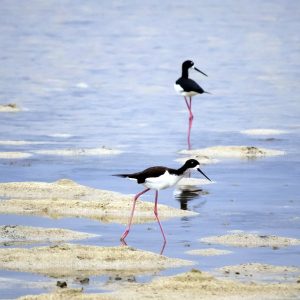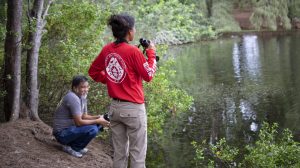Wetlands of Hawaiʻi

Wetlands are the transition zones between upland and deepwater habitats where biological communities blend and have increased diversity. Though wetlands constitute less than 3% of the State, they represent a significant economic resource to native Hawaiian communities and provide invaluable services like flood protection, sediment filtration, wildlife habitat, and recreation and education opportunities. The health of these culturally and ecologically significant areas face many threats. Learn more about wetlands in Hawaiʻi.

The ae’o or Hawaiian stilt at Paiko Lagoon, Oʻahu.
While fossil records show that at least 13 species of endemic Hawaiian waterfowl used wetlands, only three remain. The Hawaiian Stilt, Coot Moorhen and Duck, are all federally listed as endangered species and are protected by both state and federal laws. Healthy, functioning wetlands are critical to the recovery of these waterbird species. Agencies and laws help to identify natural ecosystems and protect the lands which house these areas.

DOFAW Wildlife Program staff conducting biannual waterbird surveys for Oʻahu wetlands.
DOFAW utilizes wetland management techniques to restore, enhance, protect, and maintain wetland ecosystems. Projects focus on species and habitat surveying and monitoring to assess conditions and direct management practices aimed to mitigate problems based on observations. Specific species (both plant and animal) are identified as threats to waterbirds, and a mitigation plan is formed and implemented by DOFAW staff. Mitigation steps are tracked and monitored to assess project effectiveness and to modify plans as needed to achieve management goals. General ecosystem events are also accounted for and factored into recovery efforts. These general effects include everything from weather, unusual natural phenomena, proximity of high traffic human use areas, staff/personnel issues, and any other factors that may influence habitat conditions or affect waterbirds in the wetlands.
Educational Resources for Wetlands
